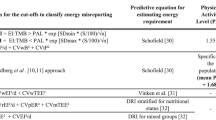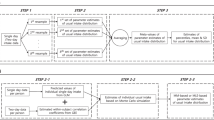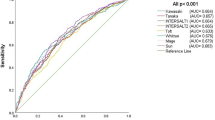Abstract
Objectives:
Within the European Prospective Investigation into Cancer and Nutrition (EPIC) study, the performance of 24-h dietary recall (24-HDR) measurements as reference measurements in a linear regression calibration model is evaluated critically at the individual (within-centre) and aggregate (between-centre) levels by using unbiased estimates of urinary measurements of nitrogen and potassium intakes.
Methods:
Between 1995 and 1999, 1072 study subjects (59% women) from 12 EPIC centres volunteered to collect 24-h urine samples. Log-transformed questionnaire, 24-HDR and urinary measurements of nitrogen and potassium intakes were analysed in a multivariate measurement error model to estimate the validity of coefficients and error correlations in self-reported dietary measurements. In parallel, correlations between means of 24-HDR and urinary measurements were computed. Linear regression calibration models were used to estimate the regression dilution (attenuation) factors.
Results:
After adjustment for sex, centre, age, body mass index and height, the validity coefficients for 24-HDRs were 0.285 (95% confidence interval: 0.194, 0.367) and 0.371 (0.291, 0.446) for nitrogen and potassium intakes, respectively. The attenuation factors estimated in a linear regression calibration model were 0.368 (0.228, 0.508) for nitrogen and 0.500 (0.361, 0.639) for potassium intakes; only the former was different from the estimate obtained using urinary measurements in the measurement error model. The aggregate-level correlation coefficients between means of urinary and 24-HDR measurements were 0.838 (0.637, 0.932) and 0.756 (0.481, 0.895) for nitrogen and potassium intakes, respectively.
Conclusions:
This study suggests that 24-HDRs can be used as reference measurements at the individual and aggregate levels for potassium intake, whereas, for nitrogen intake, good performance is observed for between-centre calibration, but some limitations are apparent at the individual level.
This is a preview of subscription content, access via your institution
Access options
Subscribe to this journal
Receive 12 print issues and online access
$259.00 per year
only $21.58 per issue
Buy this article
- Purchase on Springer Link
- Instant access to full article PDF
Prices may be subject to local taxes which are calculated during checkout
Similar content being viewed by others
References
Bingham SA, Gill C, Welch A, Cassidy A, Runswick SA, Oakes S et al. (1997). Validation of dietary assessment methods in the UK arm of EPIC using weighed records, and 24-hour urinary nitrogen and potassium and serum vitamin C and carotenoids as biomarkers. Int J Epidemiol 26 (Suppl 1), S137–S151.
Bingham SA, Williams R, Cole TJ, Price CP, Cummings JH (1988). Reference values for analytes of 24-h urine collections known to be complete. Ann Clin Biochem 25, 610–619.
Cohen A (1989). Comparison of correlated correlations. Stat Med 8, 1485–1495.
Day N, McKeown N, Wong M, Welch A, Bingham S (2001). Epidemiological assessment of diet: a comparison of a 7-day diary with a food frequency questionnaire using urinary markers of nitrogen, potassium and sodium. Int J Epidemiol 30, 309–317.
Day NE, Ferrari P (2002). Some methodological issues in nutritional epidemiology. In: Riboli E, Lambert R (eds). Nutrition and Lifestyle: Opportunities for Cancer Prevention. IARC Sci Publ No 156. International Agency for Research on Cancer: Lyon. pp 5–10.
Day NE, Wong MY, Bingham S, Khaw KT, Luben R, Michels KB et al. (2004). Correlated measurement error—implications for nutritional epidemiology. Int J Epidemiol 33, 1373–1381.
Efron B, Tibshirani RJ (1998). An Introduction to the Bootstrap. Chapman & Hall: London.
Ferrari P, Day NE, Boshuizen HC, Roddam A, Hoffmann K, Thiébaut A et al. (2008). The evaluation of the diet/disease relation in the EPIC study: considerations for the calibration and the disease models. Int J Epidemiol 37, 379–381.
Ferrari P, Friedenreich C, Matthews C (2007). The role of measurement error in estimating levels of physical activity. Am J Epidemiol 166, 832–844.
Ferrari P, Kaaks R, Fahey MT, Slimani N, Day NE, Pera G et al. (2004). Within- and between-cohort variation in measured macronutrient intakes, taking account of measurement errors, in the European Prospective Investigation into Cancer and Nutrition study. Am J Epidemiol 160, 814–822.
Ferrari P, Slimani N, Ciampi A, Trichopoulou A, Naska A, Lauria C et al. (2002). Evaluation of under- and overreporting of energy intake in the 24-hour diet recalls in the European Prospective Investigation into Cancer and Nutrition (EPIC). Public Health Nutr 5 (Suppl), S1329–S1345.
Fisher RA (1970). Statistical Methods for Research Workers, 14th edn. Hafner Publishing Company: Davien, CT.
Freedman LS, Schatzkin A, Wax Y (1990). The impact of dietary measurement error on planning sample size required in a cohort study. Am J Epidemiol 132, 1185–1195.
Heitmann BL, Lissner L (1995). Dietary underreporting by obese individuals—is it specific or non- specific? Br Med J 311, 986–989.
Johansson G, Bingham S, Vahter M (1999). A method to compensate for incomplete 24-hour urine collections in nutritional epidemiology studies. Public Health Nutr 2, 587–591.
Kaaks R, Ferrari P, Ciampi A, Plummer M, Riboli E (2002). Uses and limitations of statistical accounting for random error correlations in the validation of dietary questionnaire assessments. Public Health Nutr 5, 969–976.
Kaaks R, Plummer M, Riboli E, Esteve J, van Staveren W (1994). Adjustment for bias due to errors in exposure assessments in multicenter cohort studies on diet and cancer: a calibration approach. Am J Clin Nutr 59 (Suppl 1), S245–S250.
Kipnis V, Freedman LS, Brown CC, Hartman AM, Schatzkin A, Wacholder S (1997). Effect of measurement error on energy-adjustment models in nutritional epidemiology. Am J Epidemiol 146, 842–855.
Kipnis V, Subar AF, Midthune D, Freedman LS, Ballard-Barbash R, Troiano RP et al. (2003). Structure of dietary measurement error: results of the OPEN biomarker study. Am J Epidemiol 158, 14–21.
Kristal AR, Peters U, Potter JD (2005). Is it time to abandon the food frequency questionnaire? Cancer Epidemiol Biomarkers Prev 14, 2826–2828.
Plummer M, Clayton D (1993). Measurement error in dietary assessment: an investigation using covariance structure models, Part I. Stat Med 12, 925–935.
Prentice R (1996). Measurement error and results from analytic epidemiology: dietary fat and breast cancer. J Natl Cancer Inst 88, 1738–1747.
Riboli E, Hunt KJ, Slimani N, Ferrari P, Norat T, Fahey M et al. (2002). European Prospective Investigation into Cancer and Nutrition (EPIC): study populations and data collection. Public Health Nutr 5 (Suppl), S1113–S1124.
Riboli E, Kaaks R (2000). Invited commentary: the challenge of multi-center cohort studies in the search for diet and cancer links. Am J Epidemiol 151, 371–376.
Rosner B, Spiegelman D, Willett WC (1990). Correction of logistic regression relative risk estimates and confidence intervals for measurement error: the case of multiple covariates measured with error. Am J Epidemiol 132, 734–745.
Rosner B, Willett WC, Spiegelman D (1989). Correction of logistic regression relative risk estimates and confidence intervals for systematic within-person measurement error. Stat Med 8, 1051–1069.
SAS Institute (1999). SAS Online Doc, Version 8. SAS Institute Inc.: Cary, NC.
Schatzkin A, Kipnis V, Carroll RJ, Midthune D, Subar AF, Bingham S et al. (2003). A comparison of a food frequency questionnaire with a 24-hour recall for use in an epidemiological cohort study: results from the biomarker-based Observing Protein and Energy Nutrition (OPEN) study. Int J Epidemiol 32, 1054–1062.
Slimani N, Bingham SJ, Runswick S, Ferrari P, Day NE, Welch AA et al. (2003). Group level validation of protein intakes estimated by 24-hour diet recall and dietary questionnaires against 24-hour urinary nitrogen in the European Prospective Investigation into Cancer and Nutrition (EPIC) calibration study. Cancer Epidemiol Biomarkers Prev 12, 784–795.
Slimani N, Deharveng G, Unwin I, Southgate DA, Vignat J, Skeie G et al. (2007). The EPIC nutrient database project (ENDB): a first attempt to standardize nutrient databases across the 10 European countries participating in the EPIC study. Eur J Clin Nutr 61, 1037–1056.
Slimani N, Ferrari P, Ocké M, Welch A, Boeing H, van Liere M et al. (2000). Standardisation of the 24-hour diet recall calibration method used in the European Prospective Investigation into Cancer and Nutrition (EPIC): general concepts and preliminary results. Eur J Clin Nutr 54, 900–917.
Slimani N, Kaaks R, Ferrari P, Casagrande C, Clavel-Chapelon F, Lotze G et al. (2002). European Prospective Investigation into Cancer and Nutrition (EPIC) calibration study: rationale, design and population characteristics. Public Health Nutr 5 (Suppl), S1125–S1145.
Stram DO, Hankin JH, Wilkens LR, Pike MC, Monroe KR, Park S et al. (2000). Calibration of the dietary questionnaire for a multiethnic cohort in Hawaii and Los Angeles. Am J Epidemiol 151, 358–370.
Tasevska N, Runswick SA, Bingham SA (2006). Urinary potassium is as reliable as urinary nitrogen for use as a recovery biomarker in dietary studies of free living individuals. J Nutr 136, 1334–1340.
Thompson FE, Moler JE, Freedman LS, Clifford CK, Stables GJ, Willett WC (1997). Register of dietary assessment calibration-validation studies: a status report. Am J Clin Nutr 65 (Suppl 4), S1142–S1147.
Willett W (2001). Commentary: dietary diaries versus food frequency questionnaires—a case of undigestible data. Int J Epidemiol 30, 317–319.
Acknowledgements
The work described in this paper was carried out with the financial support of the European Commission: Public Health and Consumer Protection Directorate 1993–2004; Research Directorate-General 2005; Ligue contre le Cancer (France); Société 3M (France); Mutuelle Générale de l’Education Nationale; Institut National de la Santé et de la Recherche Médicale (INSERM); Institut Gustave Roussy; German Cancer Aid; German Cancer Research Center; German Federal Ministry of Education and Research; Danish Cancer Society; Health Research Fund (FIS) of the Spanish Ministry of Health; Spanish Regional Governments of Andalucía, Asturias, Basque Country, Murcia and Navarra and the Catalan Institute of Oncology; and ISCIII RETIC (RD06/0020), Spain; Cancer Research UK; Medical Research Council, UK; The Stroke Association, UK; British Heart Foundation; Department of Health, UK; Food Standards Agency, UK; The Wellcome Trust, UK; Greek Ministry of Health; Hellenic Health Foundation; Italian Association for Research on Cancer; Italian National Research Council, Regione Sicilia (Sicilian government); Associazione Iblea per la Ricerca Epidemiologica—ONLUS (Hyblean Association for Epidemiological Research, NPO); Dutch Ministry of Health, Welfare and Sport; Dutch Prevention Funds; LK Research Funds; Dutch ZON (Zorg Onderzoek Nederland); World Cancer Research Fund (WCRF); Swedish Cancer Society; Swedish Research Council; Regional Government of Skane and the County Council of Vasterbotten, Sweden; Norwegian Cancer Society; the Norwegian Research Council and the Norwegian Foundation for Health and Rehabilitation. We thank Sarah Somerville, Nicole Suty and Karima Abdedayem for their assistance with editing, and Kimberley Bouckaert and Heinz Freisling for their technical assistance.
Author information
Authors and Affiliations
Corresponding author
Additional information
Guarantor: P Ferrari.
Contributors: PF conducted the statistical analysis, prepared the tables and wrote the paper, taking into account comments from all co-authors. NS was the overall coordinator of this project and the EPIC Nutrient Database (ENDB) project. AR, MF, MJ, CB, MO, PA, AH and CB were members of the writing group and gave input on the statistical analyses, drafting of the paper and interpretation of results. The other co-authors were local EPIC collaborators who participated in the collection of dietary and other data and in the EPIC nutritional database (ENDB) project. ER is the overall coordinator of the EPIC study. All co-authors provided comments and suggestions on the manuscript and approved the final version.
Appendix
Appendix
Consider a bivariate linear regression model of the relationship between a vector of true exposure, T=(T1, T2), and the vector of observed exposure, Q=(Q1, Q2). For simplicity, if we consider the first exposure and omit any confounding variables, then the relationship has the form T1=λ10+λ11Q1+λ12Q2+ɛ1. The elements of the vector of parameters λ1=(λ11, λ12) consist of the attenuation factor for the first exposure and the contamination factor for the second exposure, respectively. Let ΣAB be the covariance matrix between random variables A and B; then λ1 can be estimated as

Elements in matrices ΣQQ and ΣQT1 can be expressed as a function of parameters estimated from the measurement error model (1). For example, the variance between T1 and Q1 can be calculated by σQ 1 T 1=β̂Q 1ς̂T 12+ς̂ɛ Q12. The term ‘ρQ1Q2 ’ represents the correlation between Q1 and Q2. Unlike the linear regression calibration model in (2), which uses R (instead of T), Q and Zk1 variables, estimates of ΣQT 1 obtained from model (1) are not affected by error correlations in questionnaire and 24-HDR measurements. An identical approach is applied for the vector λ2 for the second error-prone variable, noting that T2=λ20+λ21Q1+λ22Q2+ɛ2.
Rights and permissions
About this article
Cite this article
Ferrari, P., Roddam, A., Fahey, M. et al. A bivariate measurement error model for nitrogen and potassium intakes to evaluate the performance of regression calibration in the European Prospective Investigation into Cancer and Nutrition study. Eur J Clin Nutr 63 (Suppl 4), S179–S187 (2009). https://doi.org/10.1038/ejcn.2009.80
Published:
Issue Date:
DOI: https://doi.org/10.1038/ejcn.2009.80
Keywords
This article is cited by
-
Methods to account for uncertainties in exposure assessment in studies of environmental exposures
Environmental Health (2019)
-
Challenges in estimating the validity of dietary acrylamide measurements
European Journal of Nutrition (2013)
-
Bias in protein and potassium intake collected with 24-h recalls (EPIC-Soft) is rather comparable across European populations
European Journal of Nutrition (2012)
-
The standardized computerized 24-h dietary recall method EPIC-Soft adapted for pan-European dietary monitoring
European Journal of Clinical Nutrition (2011)
-
Energy intake and sources of energy intake in the European Prospective Investigation into Cancer and Nutrition
European Journal of Clinical Nutrition (2009)



